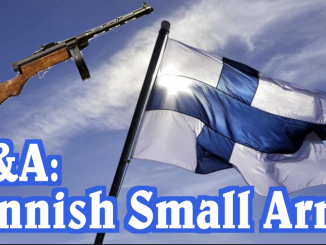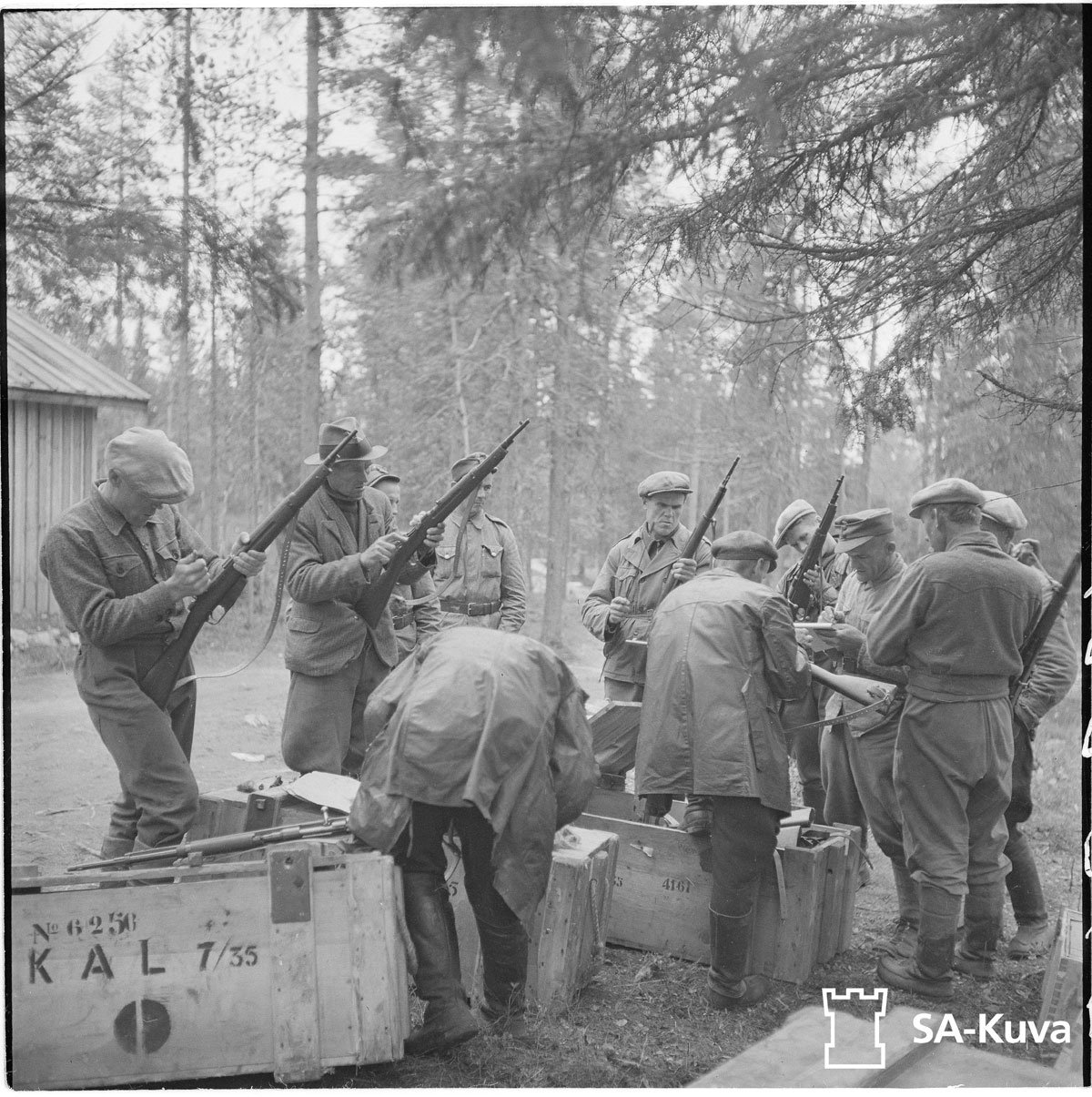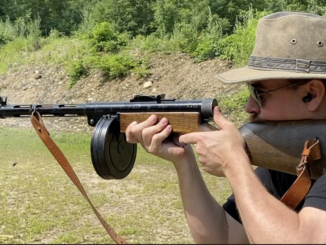The “Korsu” is a special version of the Suomi made for use in the bunkers of the Mannerheim Line. When construction on the Line really kicked into high gear in the summer of 1939, is was discovered that the vision slits in the bunkers were too small to fit the muzzle of a standard m/31 Suomi. In addition, the sights of the m/31 were uselessly located above the barrel. As a solution, the Korsu model was made. The frame was redesigned slightly into a stock-less pistol grip, and a new barrel shroud was made with a tapered muzzle that would wedge nicely into the standard construction vision ports. These new barrel shrouds also had simple fixed iron sights on the left side, making them usable when firing through ports.
The first batch of 500 Korsu model guns were made in the fall or 1939, in a serial range between approximately 5900 and 6400. A second batch of 500 more were made in January 1941, with serial numbers scattered between 13000 and 17000. They remained in Finnish inventory until the 1970s, and are very scarce today.




How to use that smg?
I do not see a mounting point at the shroud. Just lay the muzzle inside a side widening slit in the wall?
Shot one handed pistol like…two hand combat pistol style…left hand on the shroud or behind the magazine…?
With the high rate of fire from a Suomi I can not believe to hit anything smaller than a barn…
Imagine to shoot a modern 16″ pistol without brace or stock ie HK SP5L… but with 800rpm…
“Imagine to shoot a modern 16″ pistol without brace or stock ie HK SP5L… but with 800rpm…”
According to https://www.jaegerplatoon.net/MACHINEPISTOLS1.htm Korsu-kp weighted 4,35 kg whilst according to https://hk-usa.com/hk-models/sp5l/ said SP5L is 2700 grams heavy, that is 2,7 kg.
“two hand combat pistol style”
This would be rather untypical for this period, as if I am not mistaken such usage was popularized in 1950s by COOPER. WW2 standard seems to be use automatic pistol with single hand. See for example figure https://blog.krtraining.com/book-review-historical-handgun-shooting-to-live-1942-fairbairn-sykes/fairbairn-grip/ from SHOOTING TO LIVE textbook.
Shooting machine guns is about suppressive fire to discourage the attackers from getting close. Think about the volume of fire a WW2 German infantry platoon had with their Mg34s and 42s. When firing from prepared positions, area denial is more important than point accuracy. Secondly, a trained machine gunner gets very good at trigger control and physically mastering the gun and mount. Aimed shots are always an option for the soldier who is confident in the equipment.
I’m pretty sure the idea is to just push it into the firing slit until the tapered shroud bears against the slit, then use it the way you’d use e.g. a pistol-grip Browning M1919 as a bow gun on a tank. You’d have to lean into it a bit to hold it in place against recoil, but only to the tune of ~10 pounds force.
Also, sights notwithstanding, this would be an application where some 9mm tracer would go a long way. But you’re mostly going to be using a weapon like this at a few dozen meters, tops – it’s for making sure Russian soldiers don’t get close enough to stick their Mosins into the firing slits of your bunkers (or plant satchel charges or the like).
Any Russian foolish enough to poke his rifle into a firing slit will risk having the entire weapon jerked out of his hands.
We’re all speculating but recoil would be low and it looks like you could rest your grip hand against your cheek whilst and look down the sights. The support hand would need to not obstruct the sights so maybe a mag hold which along with the barrel shroud being in the port would probably be quite stable.
If you look up the cheek pistol videos by demonstrated concepts on YouTube you will see how braceless unstocked AR or AK pistols can be shot well.
The Shermans did not have a sight for the front machine gun at all, but I did not hear any complaints about this.
The use of tracers is possible, but 9×19 tracers appeared already during the continuation war.
Although, it is quite possible that the Finns have found something.
World’s first purpose-built fire port weapon?
IMHO, it makes more sense than an M231.
cheers
eon
The MP-38 might have that honor, as the scallops near the muzzle are reportedly to use from firing ports & keep the muzzle outside.
The M231 also had the requirement of helping keep poison gas out of the vehicle, hence the screw collar and the ball mount. If the Army had kept it closed bolt w/ a reasonable rate of auto fire, it not only would have kept more theoretical poison gas out, but we all might be humping around M231A1s instead of M4A1s. The road not traveled.
Ian says the rear sight is not adjustable, but it certainly looks like there are 2x screws mounting the rear sight to its bracket around the four minute mark.
On the MP-40, the so-called “takedown bar” under the barrel was actually intended as a hook to keep the muzzle outside of a tank’s pistol port when firing through same. Otherwise, if the gun was to move backward due to recoil, the vehicle hitting a bump, or etc., there would be 9 x 19mm slugs bouncing around the interior.
Considering that the “hakbusche” (“hook gun”) originally was German, the idea is a fairly old one.
It’s interesting to note that FPWs came back into style after the failure of “claymorette” belts in Vietnam. The latter’s proximity fuze systems tended to be set off by close cover, and of course there was no IFF so they were as likely to frag your own infantry as the other side’s.
FPWs fell out of favor again when IFVs were fitted with augmented armor against RPGs, which covered up the fire ports.
cheers
eon
“World’s first purpose-built fire port weapon?(…)”
Does “stationary turret gun” count as “purpose-built fire port weapon”? If yes this weapon was predated by Swiss Solothurn S-17-100 designed in 1930
https://guns.fandom.com/wiki/Steyr-Solothurn_S17-100
It was designed to be used both as a stationary turret gun and as a hip-fired submachine gun. It could be used in an infantry role, or fitted to a vehicle mount. However, it sold poorly and was not produced in quantity.
Suggestion: next time you visit Finland, how about filming a bunker on the Mannerheim Line?
All the lands on which every part of the Mannerheim Line once sat, is now within the borders of Russia.
https://upload.wikimedia.org/wikipedia/commons/2/28/Finnish_areas_ceded_in_1944.png
But Ian could visit the Salpa line, which has been kept in good condition. Salpa was intended to check Russian advances into Finland but was never needed because the Russians did not reach into Finland proper. (Salpa = lock)
These old fortifications are well worth a visit.
Then there’s around Helsinki the old Imperial Russian fortification belt whose existence even locals usually are unaware of.
Leaning into it is one thing, the mass of the Korsu-kp is another thing. Take into account that the longer barrel helps in recoil control. There was a reason Aimo disliked the muzzel brake on the suomi since it didnt really decrease recoil because there wasn’t a lot of gas pressure left to really make a difference.
Happy New Year!
Interesting story.
Indeed, I have never seen such a detailed and useful description of this device anywhere before.